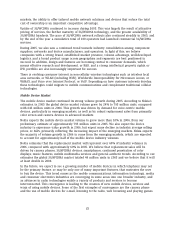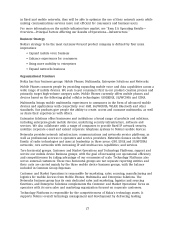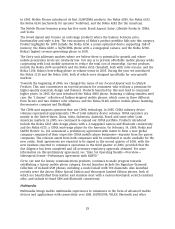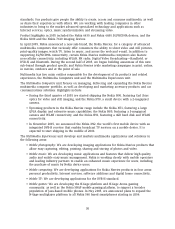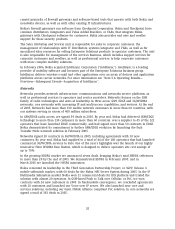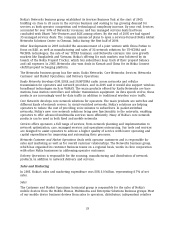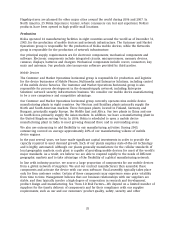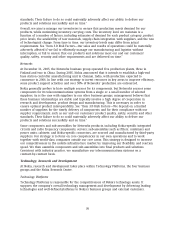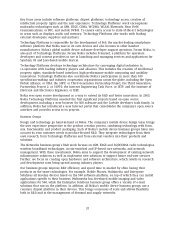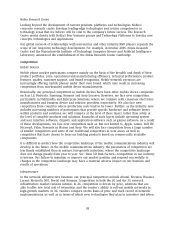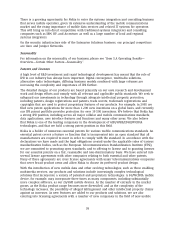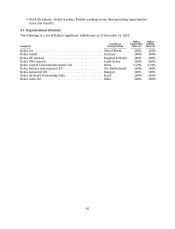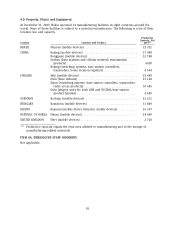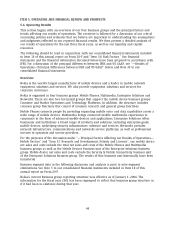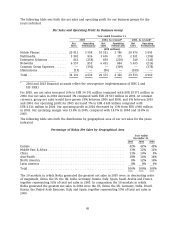Nokia 2005 Annual Report Download - page 37
Download and view the complete annual report
Please find page 37 of the 2005 Nokia annual report below. You can navigate through the pages in the report by either clicking on the pages listed below, or by using the keyword search tool below to find specific information within the annual report.Flagship stores are planned for other major cities around the world during 2006 and 2007. In
North America, 25 Nokia Experience Centers, where consumers can test and experience Nokia’s
products, have been opened in high profile mall locations.
Production
Nokia operated 14 manufacturing facilities in eight countries around the world as of December 31,
2005, for the production of mobile devices and network infrastructure. The Customer and Market
Operations group is responsible for the production of Nokia mobile devices, while the Networks
group is responsible for the production of network infrastructure.
Our principal supply requirements are for electronic components, mechanical components and
software. Electronic components include integrated circuits, microprocessors, memory devices,
cameras, displays, batteries and chargers. Mechanical components include covers, connectors, key
mats and antennas. Our products also incorporate software provided by third parties.
Mobile Devices
The Customer and Market Operations horizontal group is responsible for production and logistics
for the device businesses of Mobile Phones, Multimedia and Enterprise Solutions, including control
of the mobile device factories. The Customer and Market Operations horizontal group is also
responsible for process development in the demand-supply network, including Enterprise
Solutions’ network security infrastructure business. We consider our mobile device manufacturing
to be a core competence and competitive advantage.
Our Customer and Market Operations horizontal group currently operates nine mobile device
manufacturing plants in eight countries. Our Mexican and Brazilian plants primarily supply the
North and South American markets. Three European plants, located in Finland, Germany and
Hungary, principally supply Europe, the Middle East and Africa. Our two plants in China and one
in South Korea primarily supply the Asian markets. In addition, we have a manufacturing plant in
the United Kingdom serving Vertu. In 2006, Nokia is scheduled to open a mobile device
manufacturing plant in India to meet growing demand there and in surrounding areas.
We also use outsourcing to add flexibility to our manufacturing activities. During 2005,
outsourcing covered on average approximately 26% of our manufacturing volume of mobile
device engines.
In the past several years, we have made significant capital investments in order to provide the
capacity required to meet demand growth. Each of our plants employs state-of-the-art technology
and is highly automated. Although our plants generally manufacture for the cellular standards of
local geographic markets, each plant is capable of providing mobile devices for most of the world’s
major standards. As a result, we believe we are able to respond rapidly to the needs of different
geographic markets and to take advantage of the flexibility of a global manufacturing network.
In line with industry practice, we source a large proportion of components for our mobile devices
from a global network of suppliers. We and our contract manufacturers then assemble these
components and activate the device with our own software. Final assembly typically takes place
only for firm customer orders. Certain of these components may experience some price volatility
from time to time. Management believes that our business relationships with our suppliers are
stable, and they typically involve a high degree of cooperation in research and development,
product design and manufacturing. See ‘‘Item 3.D Risk Factors—We depend on a limited number of
suppliers for the timely delivery of components and for their compliance with our supplier
requirements, such as our and our customers’ product quality, safety, security and other
35


